9 Best AI Chatbot Examples in 2024
As we delve deeper into the digital age, artificial intelligence (AI) continues to shape and redefine our everyday experiences. One of the most fascinating advancements in this field is the development of AI chatbots. These intelligent virtual assistants are revolutionizing the way businesses interact with customers, providing round-the-clock support, instant responses, and personalized experiences.
In this article, we will zoom in and showcase our top 9 of the best examples from AI chatbots in 2024.
Part 1. What is an AI Chatbot?
An AI chatbot is a type of software designed to simulate human conversation. It uses artificial intelligence technologies, particularly natural language processing (NLP), to understand and respond to user inputs in a conversational manner.
AI chatbots can be used in a wide range of applications, including customer service, product recommendations, personal assistance, and more. They can interact with users through various platforms, such as websites, messaging apps, and social media.
Key features
- Understanding User Inputs: AI chatbots use NLP to understand user inputs, even if the phrasing or wording varies from the original programming.
- Generating Responses: Based on the user input, the chatbot generates a relevant response. Advanced chatbots can generate complex responses and carry out multi-turn conversations.
- Learning Over Time: Many AI chatbots use machine learning to improve their responses over time. They can learn from previous interactions and become more accurate and efficient.
- Integration with Other Systems: AI chatbots can often be integrated with other systems, such as databases or APIs, to provide more comprehensive responses. For example, a customer service chatbot might access a customer database to provide personalized assistance.
Part 2. How Does AI Chatbot Work?
Since we've just scratched the surface of how AI Chatbots work, let us dive in a bit deeper.
I have mentioned before that there are certain mechanisms that AI Chatbots use in order for them to sound like humans, and one is Natural Language Processing(NPL). With it, AI chatbots understand, interpret, generate, and interact with users through either text or through voice.
Next, an AI chatbot model is extensively trained, debugged, and refined using machine learning techniques. It then uses machine learning algorithms for intent recognition.
Intent recognition is the process by which the AI tries to understand the user's requests and queries. By implementing intent recognition, the AI chatbot will try to understand the intention of why you and I ask the bot something.
Lastly, dialogue management helps the AI chatbot to place our questions in the right context. And the chatbot relies on a knowledge base or database that they are built upon to answer questions or provide responses.
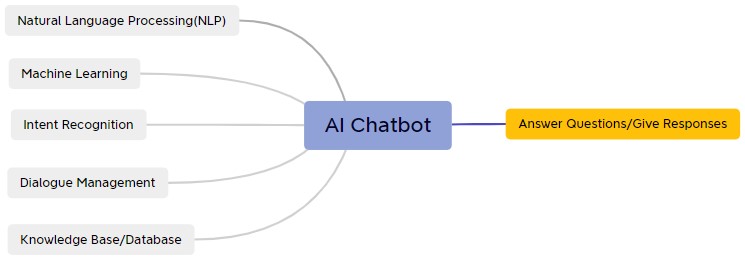
Part 3. 9 Best AI Chatbot Examples for Your Reference
Due to the vastly growing amount of AI chatbots, we believe it is hard to understand their differences. Therefore we have made a top 9 AI Chatbot examples for you to read and learn more about.
1 ChatInsight AI
Best for: AI-powered question-and-answer chatbot
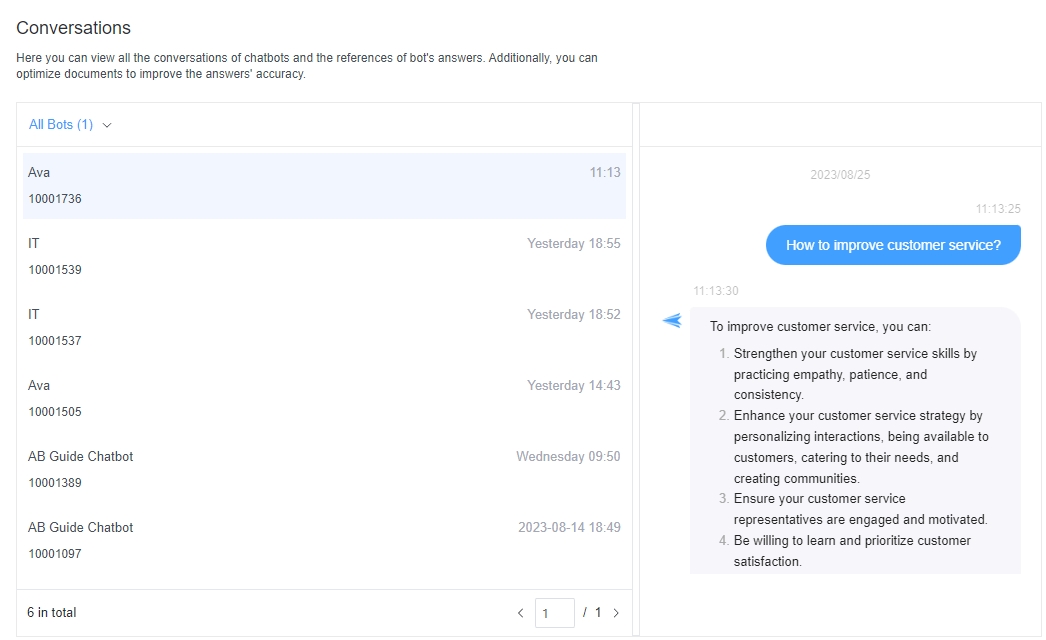
ChatInsight AI is an advanced conversational AI platform designed to enhance user interactions and provide intelligent responses. Powered by cutting-edge natural language processing and machine learning algorithms, ChatInsight AI is capable of understanding and interpreting user queries in real-time. It can provide accurate and informative answers, offer suggestions, and engage in meaningful conversations across a wide range of topics. With its ability to learn and adapt from user interactions, the AI chatbot continuously improves its performance, ensuring a seamless and satisfying user experience. Whether it's customer support, information retrieval, or general conversation, it offers a reliable and efficient solution for various chatbot applications.
Examples:
- Employee Support: Provide new hires with quick access to company files, documents, Wikipedia, etc. as a training assistant.
- Customer Support: Equip your support agents with all the assistance and FAQs they need to quickly resolve customer problems.
- IT Support: Supercharge IT team with clear guides and practical tips, helping them resolve issues faster.
- Sales Assistant: Provide sales with instant access to client information and sales processes.
2 OpenAI ChatGPT
Best for: Understand and generate impressively human-like text

OpenAI ChatGPT is a very popular free AI chatbot. One of the core strengths of this chatbot is its ability to deliver human-like interactions with its users. The bot is built upon GPT-3.5 architecture and is one of my personal favorites to use.
ChatGPT uses Natural language processing (NLP) capabilities in order for the Chatbot to respond to you in a human-like manner. Is really helpful to give you ideas for instance when it comes to writing ad copy for marketing purposes.
Examples:
- Content Creation: Assist in generating content for blogs, articles, social media posts, and more, aiding writers and marketers in their tasks.
- Entertainment: Can be used in game development for creating interactive and immersive dialogues, and it can also be used for recreational chatting.
- Language Translation: ChatGPT can assist in translating text between various languages.
- Personal Assistant: ChatGPT can help manage schedules, set reminders, and perform other personal assistant tasks.
3 Google Bard
Best for: Draw information and the most recent data from the internet

The third one on the list of examples of AI chatbots is called Google Bard. Bard is quite similar to ChatGPT (and free to use as well), however, the biggest difference is that Google Bard pulls its information from the web. One important thing to note is that this only works when you connect Bard to Google’s website index.
Bard is powered by Google’s very own LaMDA, which is Google’s own conversation technology. It is a form of NLP as we have discussed above. Bard has a lot of similar features when you compare it to ChatGPT. You can use Bard for generating ideas, for instance when it comes to generating ideas regarding content you could make for your brand.
Examples:
- Research Aid: Provide information and data on a wide range of topics, assisting researchers and students in their work.
- Market Analysis: Automate reports to offering insights on market trends.
- Storytelling: Generate unique content ideas, composing narratives, and crafting engaging articles.
- Tech Troubleshooting: Adept at troubleshooting technical issues, offering coding assistance, and providing cybersecurity advice.
4 Bing AI
Best for: Perform web searches and offer links and recommendations

Bing AI is an AI Chatbot example that is launched by Microsoft. It integrates with ChatGPT and is free to use, however, you need Microsoft Edge to use this AI Chatbot.
Due to the fact that it integrates with the Microsoft search engine, it will give you accurate answers. Like the other chatbots, Bing AI uses NLP and machine learning to understand the prompts that users provide, and it will understand your questions even if you type them in such a manner that it seems like you’re having a conversation with someone.
Examples:
- Search Optimization: Handle complex or ambiguous queries and provide relevant search results.
- Predictive Analysis: Bing uses AI for predictive analysis in various scenarios, such as predicting the outcome of popular events based on historical and real-time data.
- Image Recognition: Bing uses AI for image processing and recognition. It can identify elements within an image and provide related search results.
- Personalized Experience: Bing uses AI to personalize the user experience, tailoring search results based on previous searches and user preferences.
5 Amazon Lex
Best for: create conversational interfaces into any application
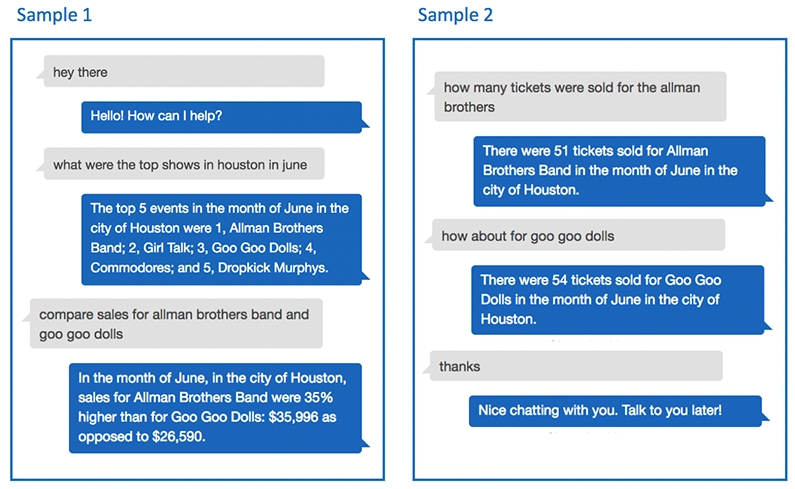
The fifth AI-based Chatbot example we’re going to discuss is Amazon Lex. Amazon Lex is a service offered by Amazon Web Services (AWS) that enables developers to build conversational chatbots and natural language interfaces into their applications.
It makes use of the same technology that powers Amazon's Alexa voice assistant which most of you are probably familiar with. The technology provides businesses with the tools to create intelligent and interactive experiences for their customers.
Examples:
- Customer Service: It can be used to create chatbots that handle customer inquiries, reducing the need for human customer service representatives.
- E-commerce and Sales: Create conversational bots that guide customers through product selections and facilitate sales transactions.
- Enterprise Productivity Bots: Build bots that integrate with enterprise software, helping employees schedule meetings, manage to-do lists, and access business data.
- Integration with the AWS platform: Integrate with AWS platform for security, monitoring, user authentication, business logic, storage, and mobile app development.
6 Writesonic
Best for: Integrates with Google Search to create content with the latest information
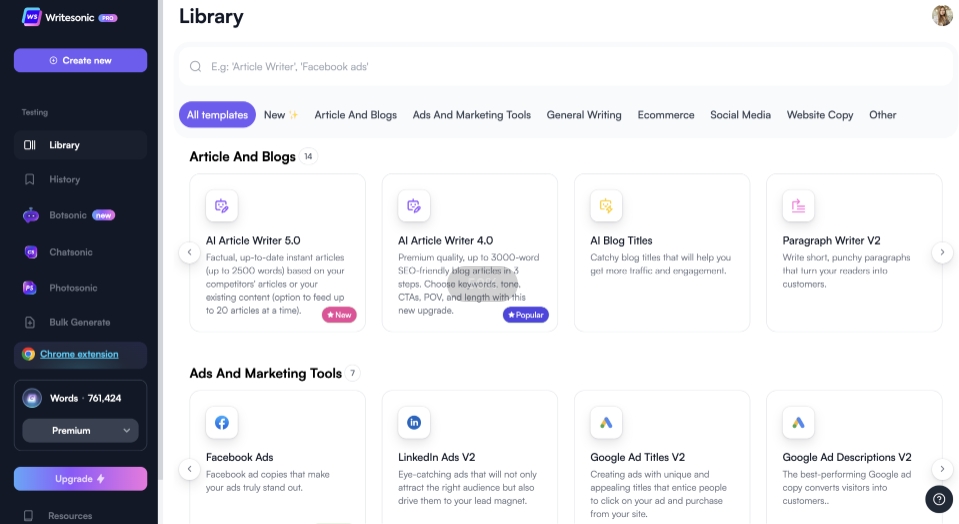
Writesonic is an AI Chatbot that is best known for providing great answers to your questions in a very personalized and interactive way.
Like the other AI Chatbot examples, Chatsonic mixes natural language understanding and something the program excels in, which is dialogue management. The chatbot compares itself to ChatGPT but with superpowers.
The AI Chatbot is integrated with Google Search, which allows the chatbot not to be limited to its own database. Chatsonic can generate images, voice commands, and more. The bot's main aim is to personalize customer interactions.

Examples:
- AI Article Writer: Help you generate long-form content by simply supplying a short input in the initial stage.
- Ads and Marketing Tools: Ad agencies and affiliate marketers can use LinkedIn Ads, Facebook Ads, Google Ads, Ad Headlines and Descriptions, etc.
- ECommerce: If you're running an e-commerce business, Writesonic can help create compelling product descriptions to attract customers.
- Copywriters and web designer: Writesonic can help draft content for landing pages, optimizing for SEO and conversion.
7 Jasper Chat
Best for: Streamline the creation and editing of articles
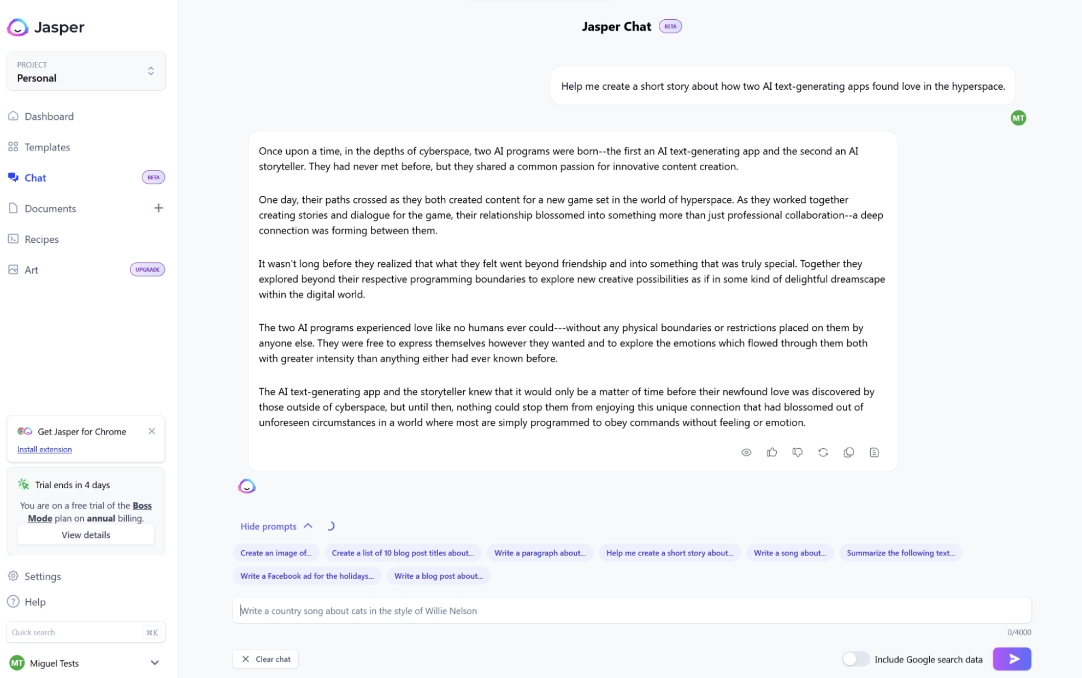
Another AI chatbot example would be Jasper Chat, which is designed for marketing companies to help them create on-brand content.
The chatbot is here to help you come up with content ideas, such as book titles or ad copy. Jasper strives to make interactions with himself just as easy as saying "Hi!". You can try the chatbot for free!
Examples:
- Blog Writing: Blog writing made better with AI-powered writing, editing, and optimization.
- Social Media Marketing: AI-powered social media tools to help you create captions and repurpose content at-scale.
- Email Marketing: Engage your audiences and increase open rates with AI-powered email marketing.
- Copywriting: Write copy that converts with Jasper's AI copywriting solutions.
8 YouChat
Best for: AI powered conversational search assistant

Like most of the chatbots in this list, YouChat is an advanced AI Chatbot designed to provide intelligent and interactive conversations with users.
The AI tool is developed by You.com and it uses something called: Large Language Model. YouChat’s core power is revolving around stepping away from the traditional search engine. You can ask the bot questions and it will provide you with fast answers, and it is letting you ask him follow-up questions in order to keep the context of the original question. The Chatbot is branded as "The AI search assistant that lives in your search engine."
YouChat can help you with learning new languages, writing your code, creating content, explaining complex concepts in simple terms, summarizing information with relevant sources, and more!
Examples:
- FAQs Answers: Answer questions that traditional search engines can’t.
- Content Creater: Write stories, blogs, emails or anything else you need.
- Learn about Recent News: It is the first large language model that can answer questions about recent events.
- Request Shopping Results: At the prompt, enter and submit the category or name of the item you want, and the results pop up.
9 IBM Watson Assistant
Best for: AI builder designed to build AI assistants

IBM Watson Assistant presents itself as a virtual agent. The chatbot is able to give fast and friendly customer care. All of this in combination with its 24/7 availability makes the technology ideal for the E-commerce landscape.
The AI is powered by large language models and is also built upon NLP like the other AI Chatbots. The bot is able to understand and process text and gain insights from business documents. By doing so it can come up with interesting insights. The best thing about all of this is that you don’t have to be able to know anything about coding.
Examples:
- Customer Support: Provide product information, and resolve common issues, offering 24/7 support and reducing the load on human customer service agents.
- Banking and Finance: Provide financial advice, enhancing customer experience in the banking sector.
- Human Resources: Assist with employee onboarding, answer HR-related queries, and help manage employee benefits and policies.
- E-commerce: Help customers with product selection, provide personalized recommendations, and assist with the checkout process.
Summary
As technology continues to advance, AI chatbots have become indispensable tools for businesses across various industries. Whether it's Siri on your smartphone or a website chatbot, the potential for AI chatbots to transform the way we interact and seek information is remarkable.








Leave a Reply.